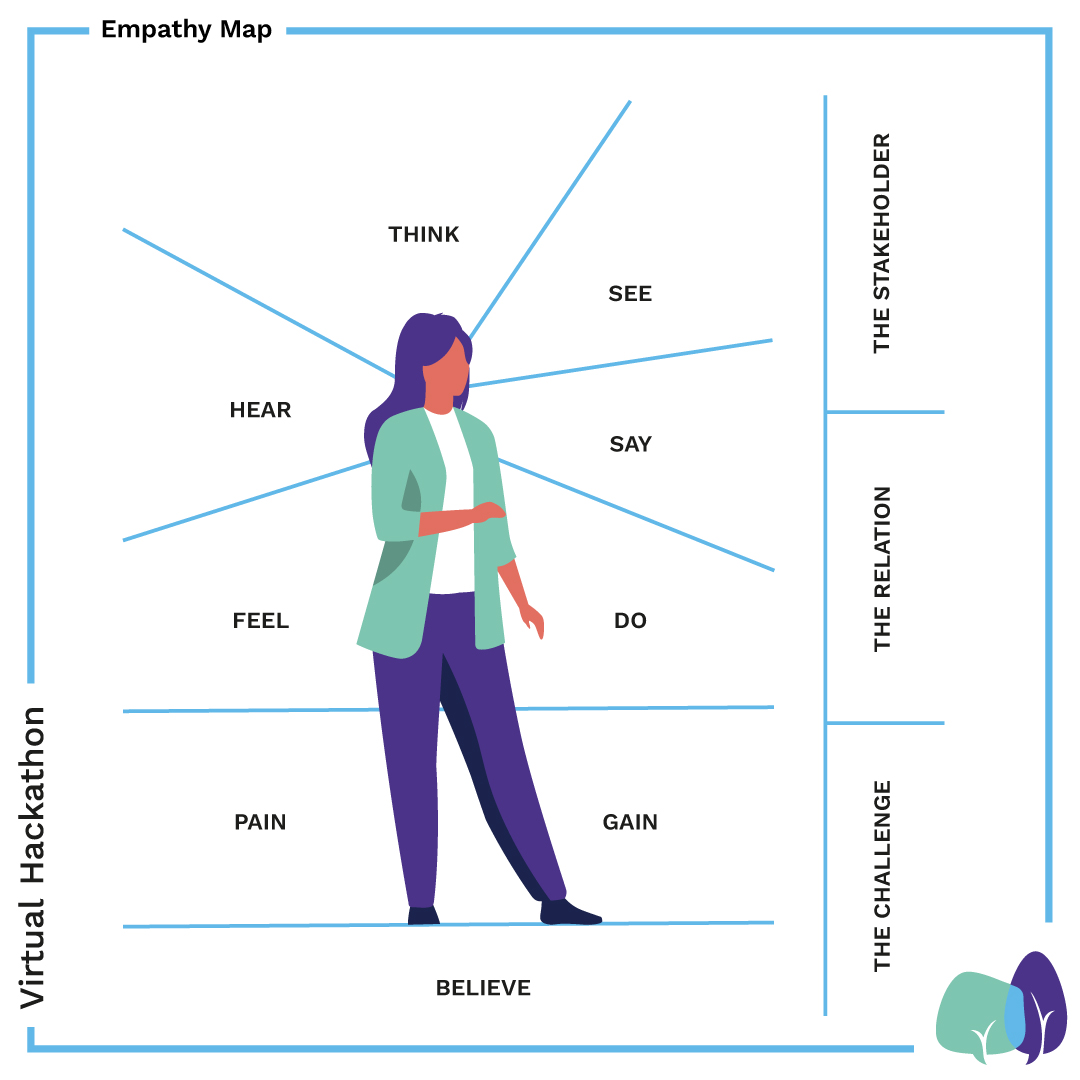Empathy Map
WHAT IT IS
The empathy map is a visual tool that allows you to build a stakeholder profile by quickly browsing the sources of information you have close at hand. The empathy map is intended for you to put yourself into a stakeholder’s shoes and thereby see the challenge from a different perspective.
WHEN TO USE
When you have carried out an identification of your potential stakeholders and want to know more about them and don’t have the time or the resources to carry out in-depth market research.
WHY IT IS USEFUL
The main value of this tool is how quickly you can get a clear and pretty accurate profile of a stakeholder.
HOW LONG
20 min each stakeholder.

THE PROCESS
STEP 1. Setting the scene (10 min)
Write down the name and a short description on the specific stakeholder to be described and put it on the upper right-hand side of the canvas. Then, pay attention to the challenge you are working on. Write the problem down on a post-it and put it on the lower right-hand side of the canvas. Finally, look at the stakeholder and how he/she relates to the challenge. Is she a prospect, a client, a user of your service/product? Is she affected by your project? Or, can she affect the process of developing a new solution? If so, in which way? Describe this relation on a post-it and place it between the stakeholder and challenge description. These three notes will provide the context for the rest of the tool.
STEP 2. Thinking and responding (10 min)
Next, the group starts trying to fill out those nine areas by responding on sticky cards to the questions linked to them. In the following paragraphs you can find a list of questions that you can use as a guideline to find your answers.
Just write them down and put them on the canvas.
THINK (brain)
“What does he really care about?”, “What is her endgame/ deep belief?”, “What do they think about the challenge and the current market solution?”, “How do they think about their fears and hopes?”
SEE (eyes)
“What do they see when they face the problem/challenge in their daily life?”, “What TV programs does she watch?”, “What is the context/environment they see around them?”, “What technology/ solutions does the market offer?”, “What does a typical day look like in their world?”…
HEAR (ears)
“What do their friends/boss relatives… say?”, “What influencers do they follow and what do they say?”, “Who does he really listen to?”, (radio, forums, social media...), “What do they hear when other people use the same technology or face the same problem?”, “Is she following the big players?”
SAY (mouth)
“What does she say regarding the challenge in a conversation?”, “Is he inspired by an inspirational idea when talking about the problem?”, “What do they say when using the current technology?”, “What opinions do they state about innovative solutions?”
FEEL (heart)
“What do they feel when using the technology, whether in private or public?”, “What are his feelings regarding the players in the market and society, related to the challenge?”
DO (arms/hands)
“What is their attitude in public when it comes to interacting with the technology or problem?, “What is her behaviour when using the current solutions?”, “Is he trying to do anything to defy or modify the status quo?”
PAIN (back)
“What are the barriers they face in their day-to-day life?”, “What are their pain points when using the current solution?”, “What are their concerns about new solutions and future changes?”
GAIN (legs)
“What do they really want from the technology?”, “What are her actual needs?”, “How do they measure success?” “What are his expectations regarding the problem in terms of solutions and general environment?”
BELIEVE (feet)
“What do they actually believe?”, “What are their thoughts rooted in?”, “What are their implicit and explicit assumptions about the challenge? (technology, how society reacts…)”
When you look at the completed canvas, spend some minutes reflecting on the process and the outcome.
PRACTICAL TIPS
- This is a technique that can be enriched with others such as stakeholder interviews, shadowing, market analysis, etc.
- When searching for information try to find out what other stakeholders think about the one you are working on. It might make you change your opinion and answers.
- If there are opposite answers in some areas, keep them on the canvas, bear in mind human complexity and the fact that sometimes both answers might be right under specific circumstances.